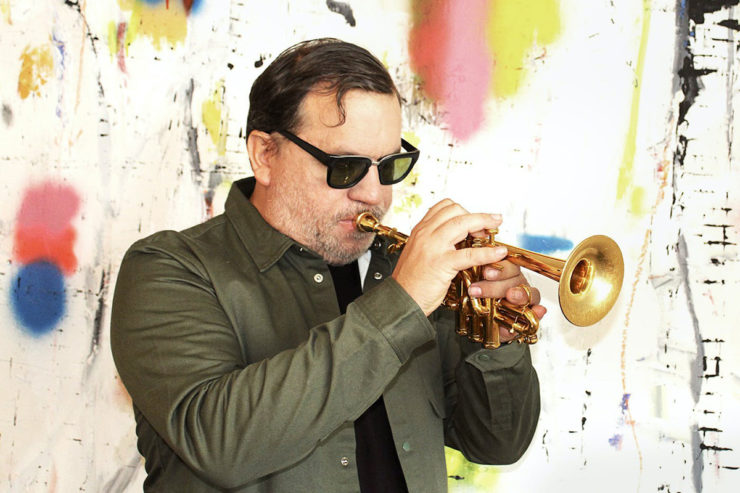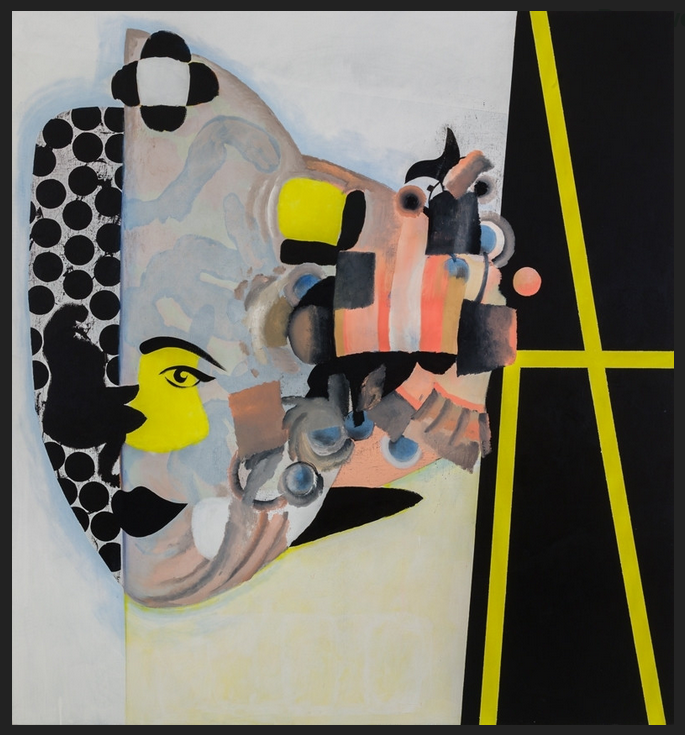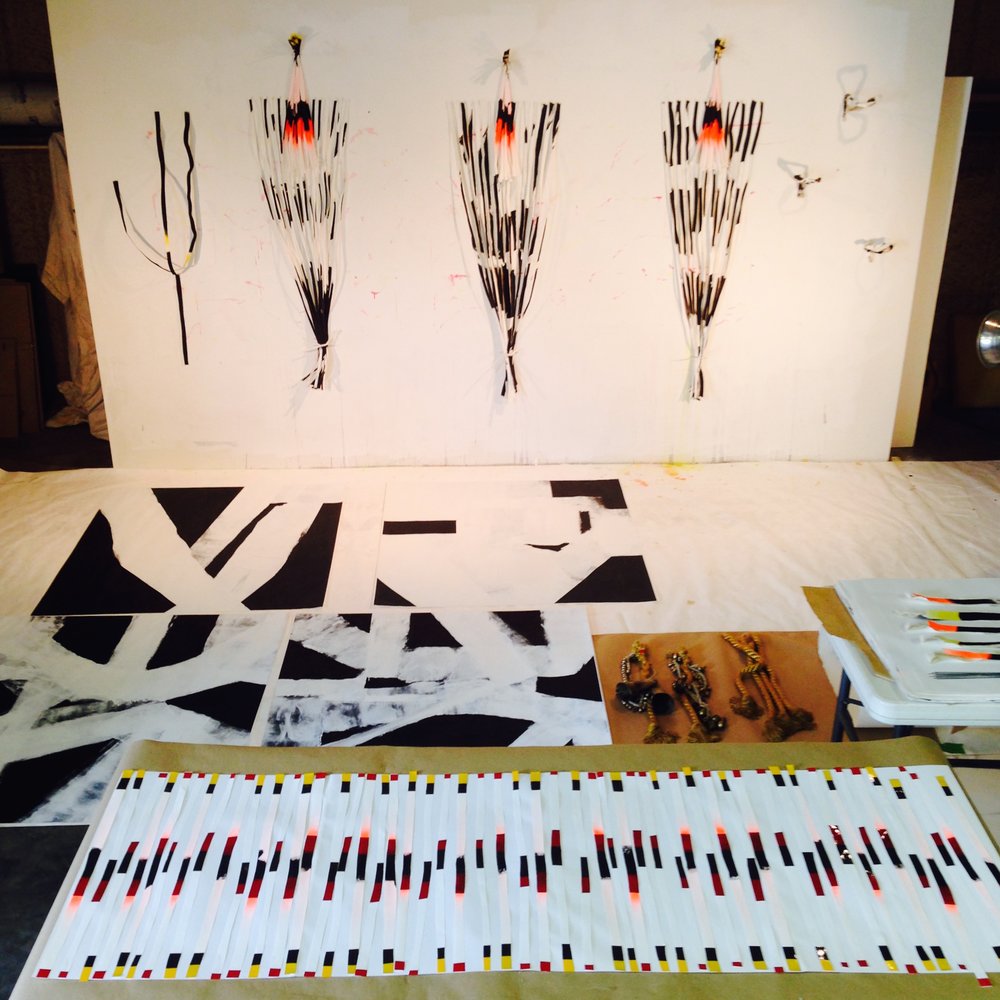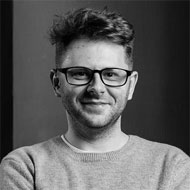
W tym roku ukazały się już dwa albumy Roba Mazurka, o czym udało się porozmawiać z artystą, a także o innych aspektach jego twórczości.
Rob Mazurek to multidyscyplinarny artysta/abstraktywista, skupiający się na tworzeniu m.in. kompozycji elektroakustycznych czy improwizowanych. Poza tym zajmuje się sztuką performance’u, malarstwem, rzeźbą, sztuką wideo, filmem i instalacjami. Większość swojego twórczego życia spędził w Chicago, a następnie w Brazylii. Obecnie mieszka i pracuje w Marfie w Teksasie z żoną Britt Mazurek.
Mazurek to bez wątpienia jeden z najważniejszych muzyków (trębaczy) współczesnego świata, nieustannie poszukujący nowych form bądź łączący ze sobą wiele różnych gatunków, dziedzin.
⇒ For english version scroll down
Łukasz Komła: Niedawno francuska wytwórnia RogueArt opublikowała dwa twoje albumy, jeden z nich Father’s Wing nagrałeś w kwartecie z Kris Davis, Ingebritem Håker Flatenem i Chadem Taylorem, zaś drugi to materiał solowy All Distances Inform. W pierwszej kolejności zapytam cię o Father’s Wing. Ja bardzo dobrze pamiętam twój wspaniały materiał nagrany jako Rob Mazurek and Black Cube SP – Return the Tides: Ascension Suite and Holy Ghost poświęcony pamięci twojej mamy, Kathleen Mazurek. Czy Father’s Wing jest formą pożegnania z twoim ojcem, hołdem dla niego bądź czymś jeszcze innym czego nie można ująć w prostych słowach?
Rob Mazurek: Tak, Father’s Wing zadedykowałem pamięci mojego Ojca. Utwór, w formie długiej ballady, został skomponowany wkrótce po jego śmierci. Zajęło mi trochę czasu napisanie tego, ale kiedy już powstał, pięknie popłynął.
Jak wspominasz sesję w studiu podczas nagrywania Father’s Wing?
To było piękne. Nagrywałem materiał z Kenem Christiansonem w jego studio w Chicago. Sesja odbyła się w bardzo rodzinnej i emocjonalnej atmosferze. Wszyscy grali świetnie. Wspaniała akustyka i wyczucie.
Solowy materiał All Distances Inform na trąbkę piccolo nagrałeś w Muzeum Sztuki Współczesnej w Marfa w Teksasie. Czy korzystałeś wtedy z elektroniki? Czy te wszystkie pogłosy pochodzą z naturalnego środowiska tego miejsca?
Nagrałem tę muzykę w Chinati Foundation, która jest skarbnicą sztuki opracowanej przez Donalda Judda, do której on zaprosił m.in. Johna Chamberlaina, Dana Flavina i innych. Ta Fundacja była jednym z powodów, dla których przeprowadziłem się do Marfy. Uwielbiam sztukę i ten pomysł Judda na stałą instalację jest bardzo ciekawy i ważny. Połowę materiału nagrałem w przestrzenie znanej pod nazwą 100 aluminum box (miejsce utworzone w 1986 r. przez Donalda Judda – przyp. red.), a drugą część u Johna Chamberlaina. Przestrzeń z aluminiowymi pudłami działała jak pewien rodzaj załamującej się partytury, z którą można pracować, ponieważ elementy stale się zmieniają w oparciu o naturalne światło wpadające do przestrzeni, zaś Chamberlain czasami dokładał rzeźby zmiażdżonych aut, działające na trąbkę piccolo jak gigantyczne tłumiki. Wszystko zostało zarejestrowane akustycznie. Poruszałem się od końca pomieszczenia do obszaru, w którym umieściliśmy mikrofony stereo. Mikrofony stały nieruchomo, więc naprawdę eksperymentowaliśmy z pomysłem przechwytywania dźwięku z różnych odległości, a także obserwowaliśmy w jaki sposób dźwięk naturalnie odbijał się w tej przestrzeni oraz jak zachowywał się poza tymi pięknymi rzeźbami i wokół nich.
Jaki przekaz niesie tytuł albumu All Distances Inform?
Wszystko jest zawarte w tym świetnym tytule, jak i samy wierszu Tima Johnsona All Distances Inform, którego przesłaniem są odległości i ich wpływ na architekturę.
W notce dołączonej do „All Distances Inform” pojawia się fragment, w którym jest mowa o Charlesie Olsonie – amerykańskim poecie, pisarzu i profesorze związanym przez wiele lat Black Mountain College w Północnej Karolinie. Ten akademicki ośrodek wspierał prace m.in. Johna Cage’a, Allena Ginsberga. Transdyscyplinarna poezja Olsona opierała się na wielu odmiennych i różnych źródłach. Był wyznawcą koncepcji otwartej pozycji, opartej na spontanicznym wyrażaniu siebie. Bez cienia wątpliwości działalność Olsona wpłynęła na całe pokolenia amerykańskich poetów. Jaki jest twój stosunek do prac Olsona?
On jest mistrzem idei i ekstrapolacji ich do dziedzin, które bynajmniej nie są tak powszechne u wielu piszących. À propos, odnajduję odniesienie do jego twórczości w kontekście szczególnego sposobu rejestrowania i prezentowania.
Z tego, co wiem, przeprowadziłeś się z Brazylii do Teksasu, do miasta Marfa. Dlaczego akurat tam osiadłeś?
Przeniosłem się do Marfy przede wszystkim ze względu na jej malownicze piękno i na pewno też ze względu na sztukę. Jest to miejsce sprzyjające koncentracji, ale także umożliwiające postrzeganie w inny sposób różnych aspektów życia na tej planecie. To małe miasto ma bardzo silną społeczność artystyczną, a wśród nich: pisarze, muzycy, poeci, filmowcy, którzy cały czas tu przyjeżdżają lub mieszkają. Dość często wpadniesz na kogoś, kto wykonuje błyskotliwą pracę w jednej lub kilku dyscyplinach i zanim się zorientujesz, jesz z nimi obiad i odwiedzasz studia Christophera Woola albo Charline Von Heyl. Następnie ścierasz się ze wspaniałym dramatopisarzem Richardem Maxwellem, a potem trafiasz nawet do jednej z jego prac. Mam w domu wspaniałe studio dźwiękowe i artystyczne, które nazywam Marfa Experimental Studio. To miejsce do głębokiej kontemplacji i działania.


Fascynuje mnie Teksas, jego pustynny ekosystem. Czy wyprawiasz się czasami w głąb pustynnych terenów tego stanu? Przyznam, że marzy mi się twoja muzyka nagrana gdzieś wśród przyrody, jakiś eksperyment z udziałem natury. Czy myślałeś nad czymś takim?
Tak… ale proszę sobie uświadomić, że Marfa znajduje się w głębi pustyni. W bardziej ekstremalnym rozumieniu kiedyś to było dno oceanu. Otacza nas Park Narodowy Big Bend i przepływająca przez niego rzeka Rio Grande. Masz tu niesamowite naturalne piękno, w otoczeniu którego zrobiłem kilka nagrań i stworzyłem niezwykłe instalacje tuż za miastem, w tej wspaniałej nowej przestrzeni w Marfie zwanej maintenant, co w języku francuskim oznacza „teraz”, prowadzonej przez moich przyjaciół Sabrinę i Jeffa. Udało mi się przygotować instalację na dużą skalę, która tak naprawdę jest tym kierunkiem, w jaki zamierzam bardziej intensywniej pójść. Od wielu lat jestem artystą w dziedzinie malarstwa, rzeźby, sztuki wideo, tekstu, dźwięku. Możliwość rozwoju we wszystkich tych kierunkach jest ważną częścią bycia tutaj. Ten obszar jest również określany jako dark sky, czyli jedno z najciemniejszych miejsc w Stanach Zjednoczonych, więc oglądanie tu gwiazd jest absolutnie cudownym doświadczeniem.
Jakie są twoje plany artystyczne na najbliższą przyszłość?
Kilka miesięcy temu podczas paryskiego festiwalu Sons d’Hiver Paryżu odbyła się premiera pierwszego aktu mojej 13-aktowej eksperymentalnej opery, więc w przyszłości chcę zaprezentować ją w innych miejscach. Prawie gotowe są już nowe nagrania Exploding Star Orchestra i prawdopodobnie zostaną wydane jesienią tego roku lub na początku 2023 roku nakładem wytwórni International Anthem. Tworzę obrazy, rzeźby i instalacje, które zaczną krążyć po świecie w 2023 roku i pracuję nad zrzutem NFT, który pojawi się tutaj pod koniec czerwca.
Strona Roba Mazurka: www.robmazurek.com Strona Facebook Roba Mazurka: www.facebook.com/androidlovecry
⇒ For english version
Łukasz Komła: Recently, the French label RogueArt released two of your albums, one of them Father’s Wing you recorded in a quartet with Kris Davis, Ingebrit Håker Flaten and Chad Taylor, and the other is the solo material of All Distances Inform. First, let me ask you about the Father’s Wing. I remember very well your wonderful album recorded as Rob Mazurek and Black Cube SP – Return the Tides: Ascension Suite and Holy Ghost, dedicated to the memory of your mother, Kathleen Mazurek. Is Father’s Wing a form of saying goodbye to your father, paying tribute to him or anything else that cannot be put into simple words?
Rob Mazurek: Yes, Father’s Wing is a dedication to the memory of my Father. The song, a long form ballad was composed soon after he passed. It took me a while to write this, but when it came out it flowed beautifully.
How do you remember the studio session while recording Father’s Wing?
It was beautiful. Recorded with Ken Christianson at his studio in Chicago. It was a very family-like atmosphere and emotional of course. Everyone played great. Wonderful acoustics and feel.
You recorded your solo material All Distances Inform for piccolo trumpet at the Museum of Contemporary Art in Marfa, Texas. Did you use electronics then? Are all these reverbs from the natural environment of this place?
I recorded this music at the Chinati Foundation, which is a treasure trove of art developed by Donald Judd, with Judd inviting the likes of John Chamberlain, Dan Flavin and others. This foundation was one of the reasons I moved to Marfa. I love the art and this idea of Judds of the permanent installation is very interesting and important. I recorded half the material in the 100 aluminum box spaces and the other half in the John Chamberlain space. The aluminum box space acted as a kind of refracting score to work with, as the pieces are constantly changing based on the natural light coming into the space, and the Chamberlain crushed car sculptures at times, acting as giant mutes for the piccolo trumpet. Everything was recorded acoustically. I moved from the back of the spaces into the area where the stereo mics were placed. The mics were stationary, so we really experimented with this idea of capturing sound at various distances, how the sound naturally reverberated in the space and how the sound behaved off and around these beautiful sculptures.
What is the message of the album title?
Tim Johnson’s excellent title and poem All Distances Inform, speaks of this. The premise being distance and how this informs the architecture.
In a note attached to All Distances Inform there is a passage about Charles Olson – an American poet, writer and professor associated for many years at Black Mountain College in North Carolina. This academic center supported the work of, inter alia, John Cage, Allen Ginsberg. His transdisciplinary poetry was drawn from many different and different sources. He was a follower of the concept of open position, based on spontaneous self-expression. Without a shadow of a doubt, Olson’s work influenced generations of American poets. What is your attitude to Olson’s work?
He is a master of idea and extrapolation of an idea into realms not so prevalent in a lot of writing. I find the reference to his work apropos for this particular way of recording and presentation.
As far as I know, you moved from Brazil to Texas, to the city of Marfa. Why did you settle there?
I moved to Marfa primarily because of its scenic beauty, certainly the art and it’s a place to concentrate, but also to perceive different aspects of living on this planet in a different manner. The small town has a super strong art community with artists, writers, musicians, poets, film makers, coming in all the time or living here. You will quite frequently bump into someone who is doing brilliant work in one or more of the disciplines and before you know it, you are having dinner and visiting the studios of Christopher Wool or Charlene Von Heyl, or rubbing shoulders with the great playwright Richard Maxwell and then often times you will find yourself even acting in one of his works. I have a wonderful sound and art studio here at my house which I call Marfa Experimental Studio. It’s a place for deep contemplation and action.


I am fascinated by Texas and its desert ecosystem. Do you ever travel deep into the desert areas of this state? I admit that I dream of your music recorded somewhere in nature, eg Texas, some experiment with nature. Have you thought about something like this?
Yes… but please realize that Marfa is in the DEEP DESERT. This was once the bottom of the ocean… but to a more extreme extent, Big Bend National Park surrounds us and the Rio Grande runs through. So you have amazing natural beauty here, and I have done some recording in these areas and I have been doing these wonderful installations just outside of town at this wonderful new space here in Marfa called MAINTENANT… which means NOW in French, run by my friends Sabrina and Jeff. I have been able to do large scale installation which is really more of what I intend to move more intensely into. I am an Artist in the realm of painting, sculpture, video, text, sound for many years now. Having this opportunity to expand in all directions is an important part of being here. This area is also DARK SKY designated… so its one of the darkest places in the US, so viewing and experiencing the stars is absolutely wonderful.
What are your artistic plans for the near future?
I premiered the first act of a 13 act experimental Opera at Sons d’Hiver festival in Paris a few months ago… so we are planning on presenting that at more spaces in the future… Also a new Exploding Star Orchestra recording is almost done, and all this will be released on International Anthem Records probably in the fall or early 2023. I have been making paintings, sculptures and installations that will start to move around the world in 2023 and am working on an NFT drop coming up here at the end of June.
The website of Rob Mazurek: www.robmazurek.com Facebook page Rob Mazurek: www.facebook.com/androidlovecry

